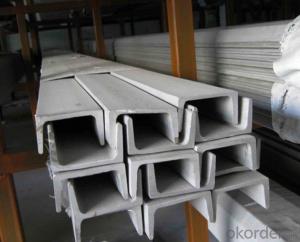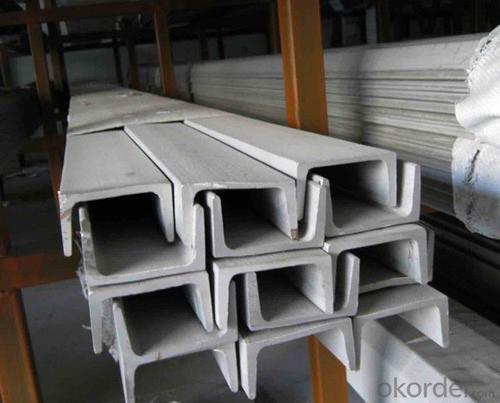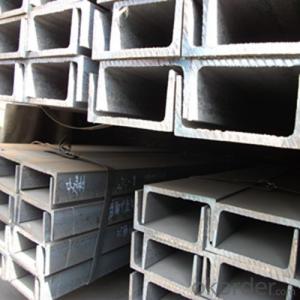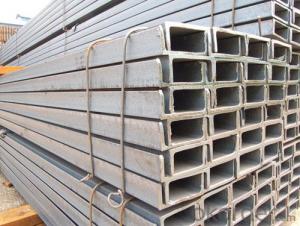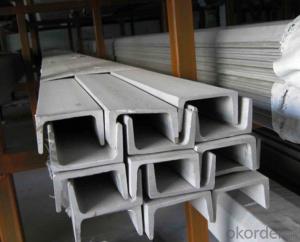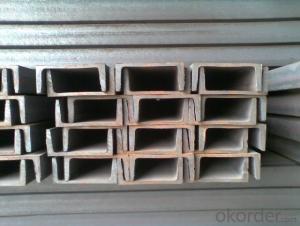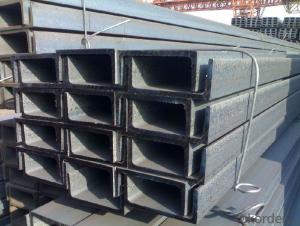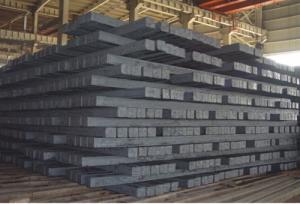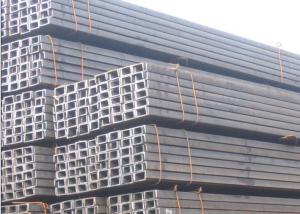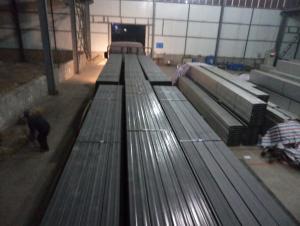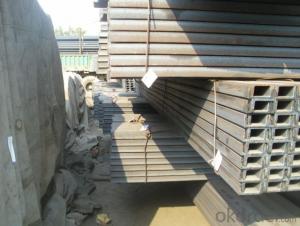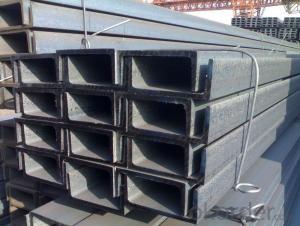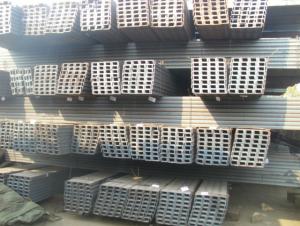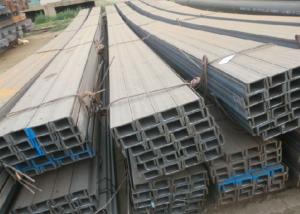GB U Channel JIS or UPN 50-300MM Hot Rolled
- Loading Port:
- Tianjin
- Payment Terms:
- TT OR LC
- Min Order Qty:
- 25 m.t.
- Supply Capability:
- 20000 m.t./month
OKorder Service Pledge
OKorder Financial Service
You Might Also Like
Product Description:
OKorder is offering GB U Channel JIS or UPN 50-300MM Hot Rolled at great prices with worldwide shipping. Our supplier is a world-class manufacturer of steel, with our products utilized the world over. OKorder annually supplies products to European, North American and Asian markets. We provide quotations within 24 hours of receiving an inquiry and guarantee competitive prices.
Product Applications:
According to the needs of different structures,GB U Channel JIS or UPN 50-300MM Hot Rolled can compose to different force support component, and also can be the connections between components. It is widely used in various building structures and engineering structures such as roof beams, bridges, transmission towers, hoisting machinery and transport machinery, ships, industrial furnaces, reaction tower, container frame and warehouse etc
Product Advantages:
OKorder's GB U Channel JIS or UPN 50-300MM Hot Rolled are durable, strong, and resist corrosion.
Main Product Features:
· Premium quality
· Prompt delivery & seaworthy packing (30 days after receiving deposit)
· Corrosion resistance
· Can be recycled and reused
· Mill test certification
· Professional Service
· Competitive pricing
Product Specifications:
Manufacture: Hot rolled
Grade: Q195 – 235
Certificates: ISO, SGS, BV, CIQ
Length: 6m – 12m, as per customer request
Packaging: Export packing, nude packing, bundled
Sizes: 25mm-250mm | ||||||||||
a*t | ||||||||||
25*2.5-4.0 | 70*6.0-9.0 | 130*9.0-15 | ||||||||
30*2.5-6.6 | 75*6.0-9.0 | 140*10-14 | ||||||||
36*3.0-5.0 | 80*5.0-10 | 150*10-20 | ||||||||
38*2.3-6.0 | 90*7.0-10 | 160*10-16 | ||||||||
40*3.0-5.0 | 100*6.0-12 | 175*12-15 | ||||||||
45*4.0-6.0 | 110*8.0-10 | 180*12-18 | ||||||||
50*4.0-6.0 | 120*6.0-15 | 200*14-25 | ||||||||
60*4.0-8.0 | 125*8.0-14 | 250*25 | ||||||||
FAQ:
Q1: How do we guarantee the quality of our products?
A1: We have established an advanced quality management system which conducts strict quality tests at every step, from raw materials to the final product. At the same time, we provide extensive follow-up service assurances as required.
Q2: How do you package the angle steel when shipping?
A2: All goods are packed in bundles with steel strips and shipped by container or break bulk.
Q3: The products are invoicing on theoritical weight or on actual weight?
A3: We can do it in both manners, according to the customers' request.
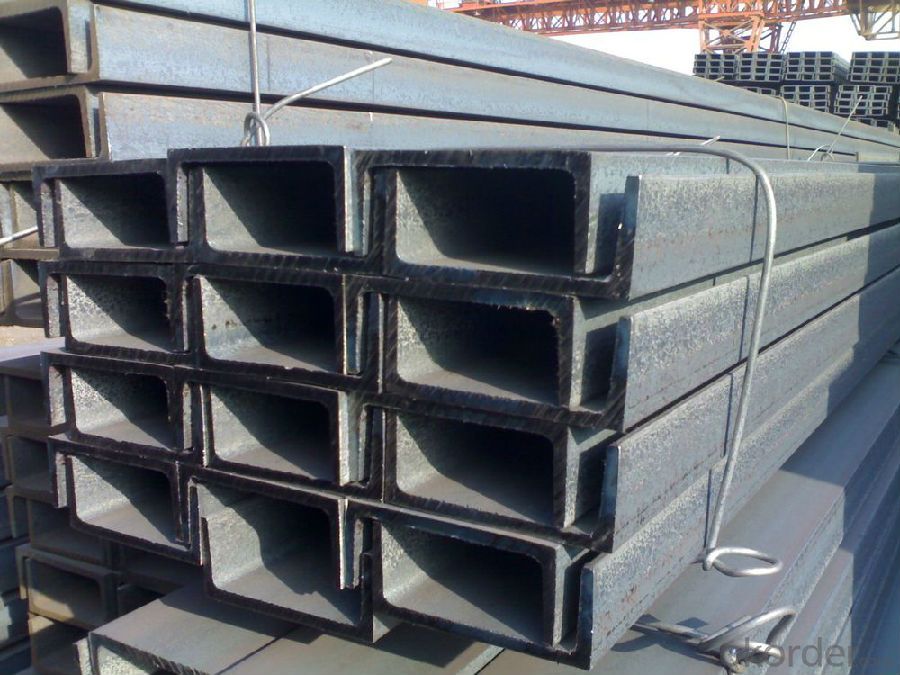

- Q: What is the typical lifespan of steel channels?
- The lifespan of steel channels can differ depending on various factors such as the quality of the steel used, the installation environment, and the level of maintenance they receive. On average, steel channels typically last between 20 and 50 years. Steel channels are widely utilized in construction and industrial settings because of their strength and durability. They are engineered to withstand heavy loads and offer structural support. However, over time, steel channels can undergo corrosion, wear and tear, and other forms of degradation. To extend the lifespan of steel channels, regular maintenance and protective measures are crucial. This includes conducting routine inspections, cleaning, and applying protective coatings or treatments to prevent corrosion. In addition, proper handling, installation, and load management practices can also contribute to prolonging their lifespan. It is important to recognize that the specific lifespan of steel channels can vary based on the specific conditions they encounter. For example, steel channels installed in coastal areas with high levels of saltwater exposure may experience faster corrosion and a shorter lifespan compared to those installed in inland regions. To determine the expected lifespan of steel channels for a particular application, it is advisable to seek guidance from structural engineers, manufacturers, or industry experts who can provide insights based on the specific project requirements and conditions.
- Q: Can steel channels be powder-coated?
- Yes, steel channels can be powder-coated.
- Q: Can steel channels be used in telecommunications towers?
- Steel channels are indeed applicable in telecommunications towers. Their strength, durability, and versatility enable a range of uses. In terms of structural support, steel channels provide stability and the ability to bear heavy loads for the tower. By fabricating and assembling the channels, they form the framework of the tower, allowing for the installation of diverse equipment like antennas, transmitters, and receivers. Moreover, the design of steel channels allows for seamless integration of cables and wiring, thereby facilitating efficient connectivity throughout the tower. Ultimately, the incorporation of steel channels in telecommunications towers guarantees a robust and dependable infrastructure for effective communication networks.
- Q: What are the different types of steel channel connections for door frames?
- Door frames commonly utilize various types of steel channel connections, including welded connections, bolted connections, riveted connections, corner brackets, and adjustable connections. The most prevalent method for steel channel door frames is welded connections. This involves welding the steel channels together at the corners to create a robust and secure frame. Alternatively, bolted connections are frequently employed. This approach entails drilling holes in the channels and inserting bolts to fasten the frame. This type of connection allows for convenient disassembly and reassembly, if necessary. Riveted connections are also utilized in steel channel door frames. This method involves drilling holes in the channels and inserting rivets to hold them together. Riveted connections offer a resilient and long-lasting connection. In some instances, corner brackets may be used to connect the steel channels. Made of steel, these brackets are affixed to the corners of the channels using screws or bolts. Corner brackets provide additional stability and strength to the door frame. Certain steel channel door frames may feature adjustable connections. These connections facilitate easy adjustment of the frame during installation to ensure it is level and plumb. Typically, screws or bolts are used to hold the channels in place, allowing for flexibility in positioning. Ultimately, the choice of steel channel connection for a door frame depends on various factors, including project requirements, desired strength and stability, and ease of installation and maintenance.
- Q: Can steel channels be customized for specific applications?
- Yes, steel channels can be customized for specific applications. Steel channels are versatile and can be fabricated and modified to meet the specific requirements of different applications. Customization can involve altering the dimensions, shape, or material composition of the steel channel to suit the needs of the application. Additionally, various surface finishes and coatings can be applied to the steel channels to enhance their performance and durability in specific environments or industries. Customization ensures that the steel channels are tailored to fit the unique demands of the application, whether it be in construction, manufacturing, infrastructure, or any other industry where steel channels are utilized.
- Q: How do steel channels compare to aluminum channels?
- Different applications require steel channels and aluminum channels due to their distinct properties and characteristics. Steel channels are renowned for their strength and durability, making them ideal for structural purposes that demand support and stability. With a high load-bearing capacity, steel channels are perfect for environments experiencing heavy foot traffic or machinery use as they exhibit exceptional resistance to impact. Moreover, when coated or galvanized, steel channels possess good corrosion resistance, rendering them suitable for outdoor applications exposed to moisture or harsh weather conditions. On the contrary, aluminum channels are lightweight and boast a high strength-to-weight ratio. This makes them a favored option in industries like aerospace where materials with strength and reduced weight are essential. Even without additional coatings, aluminum channels exhibit excellent corrosion resistance, making them ideal for outdoor applications where weight and corrosion resistance are vital considerations. When it comes to cost, steel channels typically offer a more affordable option compared to their aluminum counterparts. Steel is widely available and has lower production costs. Nevertheless, in the long run, aluminum channels can provide cost savings due to their lightweight nature, reducing transportation costs and facilitating installation. Ultimately, the choice between steel and aluminum channels depends on the specific requirements of the application, as both materials have their own advantages and disadvantages.
- Q: Are steel channels available in non-standard sizes?
- Yes, steel channels are available in non-standard sizes.
- Q: What are the different types of loads that steel channels can bear?
- Steel channels exhibit versatility as structural components capable of bearing different types of loads. The array of loads they can endure includes: 1. Compression Load: With a high load-bearing capacity, steel channels can effectively withstand compression forces. They find common usage in columns and beams, providing support for the weight of structures and facilitating vertical load transfer. 2. Tension Load: Steel channels possess the capability to resist tension loads, effectively countering forces that aim to pull or stretch the material. This attribute renders them appropriate for applications such as trusses or suspension systems. 3. Shear Load: Steel channels exhibit resilience against shear forces, which arise when two parallel forces exert themselves in opposite directions. They frequently find application in structural systems, effectively counteracting the shearing effects of horizontal loads like wind or seismic forces. 4. Bending Load: Steel channels proficiently bear bending loads, which emerge when forces are applied perpendicularly to the channel's axis. They are often utilized as beams or lintels, providing support for loads positioned over openings like doors or windows. 5. Axial Load: Steel channels are designed specifically to withstand axial loads, which act along the channel's longitudinal axis. These loads can either be compressive or tensile and are typically encountered in columns or vertical members. 6. Lateral Load: Steel channels possess the ability to bear lateral loads, which exert themselves perpendicular to the channel's longitudinal axis. These loads commonly originate from wind, earthquakes, or other horizontal forces and are effectively countered by the structural system incorporating the channel. In conclusion, steel channels offer a versatile option for structural applications due to their capacity to bear various types of loads. Their strength, durability, and flexibility render them suitable for an extensive range of construction and engineering projects.
- Q: How do steel channels perform under static loads?
- Steel channels, commonly utilized in construction and engineering applications, serve as structural components. Their performance proves outstanding when subjected to static loads, such as the weight of structures or equipment resting upon them. One notable advantage of steel channels lies in their impressive strength-to-weight ratio. Despite being relatively lightweight, they possess the ability to support heavy loads. Steel, renowned for its exceptional strength and durability, showcases these qualities in the performance of steel channels under static loads. Moreover, steel channels exhibit good resistance against deformation and deflection. When a static load is applied, these channels evenly distribute the load and resist bending or sagging. As a result, the stability and integrity of the supported structure or equipment remain intact. Additionally, steel channels boast high resistance to corrosion and environmental factors. This renders them suitable for various conditions, including outdoor and industrial environments. Furthermore, their corrosion resistance contributes to their longevity and low maintenance requirements. Aside from their mechanical properties, steel channels can be effortlessly fabricated and installed. They are available in a wide array of sizes and dimensions, allowing for flexibility in design and construction. Steel channels can be connected securely and reliably through welding or bolting. In summary, steel channels deliver exceptional performance under static loads. Their high strength, resistance to deformation, and durability establish them as a dependable choice for supporting structures and equipment.
- Q: How do steel channels contribute to the overall cost-effectiveness of a building?
- Steel channels contribute to the overall cost-effectiveness of a building by providing structural support and reducing the need for excessive materials. These channels are versatile and can be easily fabricated to fit specific requirements, which reduces waste and construction time. Additionally, steel channels have high strength-to-weight ratio, allowing for lighter building designs and lower transportation costs. Their durability and resistance to corrosion also result in long-term cost savings by minimizing maintenance and replacement expenses.
Send your message to us
GB U Channel JIS or UPN 50-300MM Hot Rolled
- Loading Port:
- Tianjin
- Payment Terms:
- TT OR LC
- Min Order Qty:
- 25 m.t.
- Supply Capability:
- 20000 m.t./month
OKorder Service Pledge
OKorder Financial Service
Similar products
Hot products
Hot Searches
Related keywords
